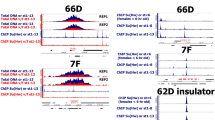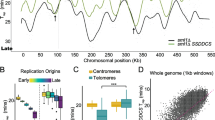Abstract
We have used gene amplification in Drosophila follicle cells as a model of metazoan DNA replication to address whether changes in histone modifications are associated with replication origin activation. We observe that replication initiation is associated with distinct histone modifications. Acetylated lysines K5, K8, and K12 on histone H4 and K14 on histone H3 are specifically enriched during replication initiation at the amplification origins. Strikingly, H4 acetylation persists at an amplification origin well after replication forks have progressed significantly outward from the origin, indicating that H4 acetylation is associated with origin regulation and not histone deposition at the replication forks. Origin recognition complex subunit 2 (orc2) mutants with severe amplification defects do not abolish H4 acetylation, whereas the dup/cdt1 mutant delays the appearance of acetylation foci, and mutants in rbf result in temporal persistence. These data indicate that core histone acetylation is associated with origin activity. Furthermore, follicle cells undergoing gene amplification exhibit high levels of histone H1 phosphorylation. The patterns of H1 phosphorylation provide insights into cell cycle states during amplification, as H1 kinase activity in follicle cells is responsive to high Cyclin E activity, and it can be abolished by overexpressing the retinoblastoma homolog, Rbf, that represses Cyclin E. These data suggest that amplification origins are able to initiate when the cells are in a late S-phase, when the genome is normally not licensed for replication.








Similar content being viewed by others
References
Aggarwal BD, Calvi BR (2004) Chromatin regulates origin activity in Drosophila follicle cells. Nature 430:372–376
Asano M, Wharton RP (1999) E2F mediates developmental and cell cycle regulation of ORC1 in Drosophila. EMBO J 18:2435–2448
Austin RJ, Orr-Weaver TL, Bell SP (1999) Drosophila ORC specifically binds to ACE3, an origin of DNA replication control element. Genes Dev 13:2639–2649
Beall EL, Manak JR, Zhou S, Bell M, Lipsick JS, Botchan MR (2002) Role for a Drosophila Myb-containing protein complex in site-specific DNA replication. Nature 420:833–837
Bosco G, Orr-Weaver TL (2002) Regulation of the cell cycle during oogenesis and early embryogenesis in Drosophila. In: DePamphilis M (ed) Regulation of gene expression at the beginning of animal development. Elsevier, Amsterdam, pp 107–154
Bosco G, Du W, Orr-Weaver TL (2001) DNA replication control through interaction of E2F-RB and the origin recognition complex. Nat Cell Biol 3:289–295
Burke TW, Cook JG, Asano M, Nevins JR (2001) Replication factors MCM2 and ORC1 interact with the histone acetyltransferase HBO1. J Biol Chem 276:15397–15408
Calvi B, Spradling A (2001) The nuclear location and chromatin organization of active chorion amplification origins. Chromosoma 110:159–172
Calvi BR, Lilly MA, Spradling AC (1998) Cell cycle control of chorion gene amplification. Genes Dev 12:734–744
Cayirlioglu P, Duronio RJ (2001) Cell cycle: flies teach an old dogma new tricks. Curr Biol 11:R178–R181
Cayirlioglu P, Ward WO, Silver Key SC, Duronio RJ (2003) Transcriptional repressor functions of Drosophila E2F1 and E2F2 cooperate to inhibit genomic DNA synthesis in ovarian follicle cells. Mol Cell Biol 23:2123–2134
Claycomb JM, Orr-Weaver TL (2005) Developmental gene amplification: insights into DNA replication and gene expression. Trends Genet 21:149–162
Claycomb JM, MacAlpine DM, Evans JG, Bell SP, Orr-Weaver TL (2002) Visualization of replication initiation and elongation in Drosophila. J Cell Biol 159:225–236
Claycomb JM, Benasutti M, Bosco G, Fenger DD, Orr-Weaver TL (2004) Gene amplification as a developmental strategy: isolation of two developmental amplicons in Drosophila. Dev Cell 6:145–155
De S, Brown DT, Lu ZH, Leno GH, Wellman SE, Sittman DB (2002) Histone H1 variants differentially inhibit DNA replication through an affinity for chromatin mediated by their carboxyl-terminal domains. Gene 292:173–181
Deng WM, Althauser C, Ruohola-Baker H (2001) Notch-delta signaling induces a transition from mitotic cell cycle to endocycle in Drosophila follicle cells. Development 128:4737–4746
Diffley JF (1996) Once and only once upon a time: specifying and regulating origins of DNA replication in eukaryotic cells. Genes Dev 10:2819–2830
Diffley JF, Labib K (2002) The chromosome replication cycle. J Cell Sci 115:869–872
Dimova DK, Stevaux O, Frolov MV, Dyson NJ (2003) Cell cycle-dependent and cell cycle-independent control of transcription by the Drosophila E2F/RB pathway. Genes Dev 17:2308–2320
Du W, Vidal M, Xie J-E, Dyson N (1996a) RBF, a novel RB-related gene that regulates E2F activity and interacts with cyclin E in Drosophila. Genes Dev 10:1206–1218
Du W, Xie J-E, Dyson N (1996b) Ectopic expression of dE2F and dDP induces cell proliferation and death in the Drosophila eye. EMBO J 15:3684–3692
Edgar BA, Orr-Weaver TL (2001) Endoreplication cell cycles: more for less. Cell 105:297–306
Foe VE, Odell GM, Edgar BA (1993) Mitosis and morphogenesis in the Drosophila embryo: point and counterpoint. In: Bate M, Martinez Arias A (eds) The development of Drosophila melanogaster. Cold Spring Harbor Laboratory, Cold Spring Harbor, NY, pp 149–300
Follette PJ, Duronio RJ, O’Farrell PH (1998) Fluctuations in cyclin E levels are required for multiple rounds of endocycle S phase in Drosophila. Curr Biol 8:235–238
Frolov MV, Dyson NJ (2004) Molecular mechanisms of E2F-dependent activation and pRB-mediated repression. J Cell Sci 117:2173–2181
Hammond MP, Laird CD (1985) Chromosome structure and DNA replication in nurse and follicle cells of Drosophila melanogaster. Chromosoma 91:267–278
Hendzel MJ, Wei Y, Mancini MA, Van Hooser A, Ranalli T, Brinkley BR, Bazett-Jones DP, Allis CD (1997) Mitosis-specific phosphorylation of histone H3 initiates primarily within pericentromeric heterochromatin during G2 and spreads in an ordered fashion coincident with mitotic chromosome condensation. Chromosoma 106:348–360
Iizuka M, Stillman B (1999) Histone acetyltransferase HBO1 interacts with the ORC1 subunit of the human initiator protein. J Biol Chem 274:23027–23034
Iizuka M, Matsui T, Takisawa H, Smith MM (2006) Regulation of replication licensing by acetyltransferase Hbo1. Mol Cell Biol 26:1098–1108
Knoblich J, Lehner C (1993) Synergistic action of Drosophila cyclins A and B during the G2-M transition. EMBO J 12:65–74
Knoblich JA, Sauer K, Jones L, Richardson H, Saint R, Lehner CF (1994) Cyclin E controls S phase progression and its down-regulation during Drosophila embryogenesis is required for the arrest of cell proliferation. Cell 77:107–120
Korenjak M, Taylor-Harding B, Binne UK, Satterlee JS, Stevaux O, Aasland R, White-Cooper H, Dyson N, Brehm A (2004) Native E2F/RBF complexes contain Myb-interacting proteins and repress transcription of developmentally controlled E2F target genes. Cell 119:181–193
Kuo MH, Brownell JE, Sobel RE, Ranalli TA, Cook RG, Edmondson DG, Roth SY, Allis CD (1996) Transcription-linked acetylation by Gcn5p of histones H3 and H4 at specific lysines. Nature 383:269–272
Landis G, Kelley R, Spradling AC, Tower J (1997) The k43 gene, required for chorion gene amplification and diploid cell chromosome replication, encodes the Drosophila homolog of yeast origin recognition complex subunit 2. Proc Natl Acad Sci USA 94:3888–3892
Lewis PW, Beall EL, Fleischer TC, Georlette D, Link AJ, Botchan MR (2004) Identification of a Drosophila Myb-E2F2/RBF transcriptional repressor complex. Genes Dev 18:2929–2940
Lilly MA, Spradling AC (1996) The Drosophila endocycle is controlled by cyclin E and lacks a checkpoint ensuring S-phase completion. Genes Dev 10:2514–2526
Lin CM, Fu H, Martinovsky M, Bouhassira E, Aladjem MI (2003) Dynamic alterations of replication timing in mammalian cells. Curr Biol 13:1019–1028
Lopez-Schier H, St Johnston D (2001) Delta signaling from the germ line controls the proliferation and differentiation of the somatic follicle cells during Drosophila oogenesis. Genes Dev 15:1393–1405
Lu MJ, Dadd CA, Mizzen CA, Perry CA, McLachlan DR, Annunziato AT, Allis CD (1994) Generation and characterization of novel antibodies highly selective for phosphorylated linker histone H1 in Tetrahymena and HeLa cells. Chromosoma 103:111–121
Lu MJ, Mpoke SS, Dadd CA, Allis CD (1995) Phosphorylated and dephosphorylated linker histone H1 reside in distinct chromatin domains in Tetrahymena macronuclei. Mol Biol Cell 6:1077–1087
Lu ZH, Sittman DB, Romanowski P, Leno GH (1998) Histone H1 reduces the frequency of initiation in Xenopus egg extract by limiting the assembly of prereplication complexes on sperm chromatin. Mol Biol Cell 9:1163–1176
Mariani BD, Lingappa JR, Kafatos FC (1988) Temporal regulation in development: negative and positive cis regulators dictate the precise timing of expression of a Drosophila chorion gene. Proc Natl Acad Sci USA 85:3029–3033
Pacek M, Walter JC (2004) A requirement for MCM7 and Cdc45 in chromosome unwinding during eukaryotic DNA replication. EMBO J 23:3667–3676
Parks S, Spradling A (1987) Spatially regulated expression of chorion genes during Drosophila oogenesis. Genes Dev 1:497–509
Royzman I, Whittaker AJ, Orr-Weaver TL (1997) Mutations in Drosophila DP and E2F distinguish G1-S progression from an associated transcriptional program. Genes Dev 11:1999–2011
Royzman I, Austin RJ, Bosco G, Bell SP, Orr-Weaver TL (1999) ORC localization in Drosophila follicle cells and the effects of mutations in dE2F and dDP. Genes Dev 13:827–840
Royzman I, Hayashi-Hagihara A, Dej KJ, Bosco G, Lee JY, Orr-Weaver TL (2002) The E2F cell cycle regulator is required for Drosophila nurse cell DNA replication and apoptosis. Mech Dev 119:225–237
Spradling AC (1993) Developmental genetics of oogenesis. In: Bate M, Martinez Arias A (eds) The development of Drosophila melanogaster. Cold Spring Harbor Laboratory, Cold Spring Harbor, NY, pp 1–70
Sterner JM, Dew-Knight S, Musahl C, Kornbluth S, Horowitz JM (1998) Negative regulation of DNA replication by the retinoblastoma protein is mediated by its association with MCM7. Mol Cell Biol 18:2748–2757
Strahl BD, Allis CD (2000) The language of covalent histone modifications. Nature 403:41–45
Su TT, Campbell SD, O’Farrell PH (1998) The cell cycle program in germ cells of the Drosophila embryo. Dev Biol 196:160–170
Thomer M, May NR, Aggarwal BD, Kwok G, Calvi BR (2004) Drosophila double-parked is sufficient to induce re-replication during development and is regulated by cyclin E/CDK2. Development 131:4807–4818
Underwood EM, Briot AS, Doll KZ, Ludwiczak RL, Otteson DC, Tower J, Vessey KB, Yu K (1990) Genetics of 51D-52A, a region containing several maternal-effect genes and two maternal-specific transcripts in Drosophila. Genetics 126:639–650
Ura K, Kurumizaka H, Dimitrov S, Almouzni G, Wolffe AP (1997) Histone acetylation: influence on transcription, nucleosome mobility and positioning, and linker histone-dependent transcriptional repression. EMBO J 16:2096–2107
Vogelauer M, Rubbi L, Lucas I, Brewer BJ, Grunstein M (2002). Histone acetylation regulates the time of replication origin firing. Mol Cell 10:1223–1233
Weiss A, Herzig A, Jacobs H, Lehner CF (1998) Continuous cyclin E expression inhibits progression through endoreduplication cycles in Drosophila. Curr Biol 8:239–242
Whittaker AJ, Royzman I, Orr-Weaver TL (2000) Drosophila double parked: a conserved, essential replication protein that colocalizes with the origin recognition complex and links DNA replication with mitosis and the down-regulation of S phase transcripts. Genes Dev 14:1765–1776
Zybina EV, Zybina TG (1996) Polytene chromosomes in mammalian cells. Int Rev of Cytol 165:53–119
Acknowledgment
We thank Julie Claycomb for reading the manuscript and making critical comments. We are grateful to Brian Calvi for communicating the results before publication. We are grateful to Stephen Bell for the ORC2 and MCM antibodies and Maki Asano and Robin Wharton for the ORC1 antibodies. We thank Mani Ramaswami and his lab members for the use of the Amira software and computers. Microscopy was done at the Whitehead Institute’s Keck Imaging Center and the Arizona Cancer Center imaging core facility. We thank four anonymous reviewers for many helpful comments, especially for suggesting the “ping-pong” model in Fig. 8. T.H. was supported by the National Science Foundation–Integrative Graduate Education and Research Traineeship graduate student program in genomics at the University of Arizona and the NIH 5T32GM008659 graduate training grant. Post-doctoral support for G.B. was provided from the Margaret and Herman Sokol post-doctoral fellowship, the Damon Runyon Cancer Foundation, and the MIT/Merck post-doctoral fellowship. This work was supported by NIH grant RO1 GM57451 to T. L. O-W., NIH grant RO1 GM069462-01 to G.B.
Author information
Authors and Affiliations
Corresponding author
Additional information
Communicated by E.A. Nigg
Rights and permissions
About this article
Cite this article
Hartl, T., Boswell, C., Orr-Weaver, T.L. et al. Developmentally regulated histone modifications in Drosophila follicle cells: initiation of gene amplification is associated with histone H3 and H4 hyperacetylation and H1 phosphorylation. Chromosoma 116, 197–214 (2007). https://doi.org/10.1007/s00412-006-0092-2
Received:
Accepted:
Published:
Issue Date:
DOI: https://doi.org/10.1007/s00412-006-0092-2




